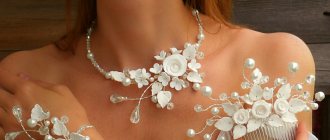Hello my dear readers. Probably, today’s article will be of interest only to ladies, since it will talk about creating a headdress for visiting church. But maybe men will read it with interest and give their significant other food for thought.
It is customary for women and girls to go to an Orthodox church in appropriate clothing and cover their heads: a dress or skirt that covers the knees, and a scarf, or, in extreme cases, a hat or beret. But the main thing is to keep your hair covered.
This has been the custom since ancient times, because women wore long hair, and walking around with bare hair was considered a shame and disgrace.
Remember in Mikhail Yuryevich Lermontov’s “Song about Tsar Ivan Vasilyevich, the young guardsman and the daring merchant Kalashnikov,” the guardsman tears off the cover of Alena Dmitrievna’s head, and how she grieves, complaining to her husband:
And my patterned scarf, your gift, and my Bukhara veil remained in the hands of the robber. He disgraced me, he disgraced me...
M.Yu.Lermontov
Today I’ll tell you how to sew a flowing scarf for a temple with your own hands from guipure for girls and women, and perhaps women will like this cut and make themselves an everyday headdress from a more modest material.
The history of the scarf in Rus' and a little about the Christian tradition
The first historical mention of headscarves dates back to 1350 BC, they were worn by Egyptian pharaohs at that time. In ancient China, warriors tied them around their necks to protect themselves from cold gusts of wind. In Rus', the headscarf was first mentioned in the 12th century.
Women wore the so-called “ubrus”, that is, rectangular linen, made later from more expensive and dense materials. It was pinned or tied under the chin. A soft small cap was worn under it - a cowberry.
According to the weather and time of year, a hoop or a large fur hat was placed on top. Of course, the fabrics from which the headdress was made were determined by the nobility and wealth of the woman wearing it.
The ubrus was replaced by a warrior and a scarf; they were a sign of maturity; they were put on after marriage and were not taken off until death, covering the hair completely. Girls in Rus' wore headbands or hats in winter, from under which their braids could be seen.
Why do people wear headscarves to church?
Since ancient times, Orthodox Christian women have covered their heads. In his First Epistle to the inhabitants of Corinth, the Apostle Paul writes about how important this is, explaining this rule by the fact that a man enters the temple with his head uncovered, as a type of God, and a woman recognizes her husband as the head of the family and honors the Lord in his person, therefore a sign of submission and humility covers the head.
By accepting this custom, girls and women testify that they belong to the Christian world, that they agree with the order established by the Church and respect its traditions.
During the cold season, many of us wear berets, caps, bonnets, and hoods to church. This is also a worthy way out, the main thing is that the lady or girl does not demonstrate her rebellious disposition and does not embarrass her neighbors with her bare-haired appearance.
Is it possible to enter church without a headscarf?
Arguing that it is not external manifestations of piety that are important to God, but only the state of our soul, then it is possible. But you always need to think about the people around you.
These are the ones you will lead into temptation, and instead of praying, they will look back at you throughout the service and silently condemn you, and some will not remain silent. That is, instead of peace and a state of peace, at the Liturgy they will fall into the sin of condemnation, and you will also commit a sin by pushing them to this.
The most regrettable thing for all those present is that there will not be a single conciliar prayer, uniting in which Christians create the Church as a community.
Therefore, it is better to adhere to generally accepted rules that require certain clothing. To avoid any unfortunate incidents, at the entrance to each church you will be given a scarf and some kind of skirt for the duration of the service.
How to beautifully tie a scarf on your head to church
There are many ways to tie scarves or stoles, each in its own way is good for its owner and does not interfere with her getting ready for prayer.
- Usually old women tie a small scarf, folded in half at the corner, in a knot under the chin. Previously, they used to pull it over the forehead to the eyebrows.
- Older women can make a knot at the back of the neck, hiding it under a loose third corner.
- Middle-aged ladies prefer to wear thin scarves, either throwing the long ends behind the back, or tying them very loosely and airily at chest level. Some people pin the scarf with small brooches or pins.
- There is a very convenient and beautiful way to tie a scarf: we throw it over the head, covering the forehead and tucking it at the temples, bring the ends behind the back and tie a small knot at the very edge. Then we straighten the scarf, pull it forward, then put it at the back of the head and drape it beautifully on the chest.
- An option like a turban is possible, in which a scarf or scarf is beautifully wrapped around the head and tied at the back.
- And the highest flight of fantasy is considered to be the so-called Don scarf or stole, created in 2010 on the Don by the Orthodox designer and fashion designer Irina Potapova and received the blessing of the chairman of the parish council of the Cathedral of the Nativity of the Blessed Virgin Mary in Rostov-on-Don. This is exactly what we will talk about today.
Why did I need to sew scarves for the temple?
I wanted to give gifts for Easter to my loved ones: my beloved daughter and beloved granddaughters. What to give for such a great holiday? Of course, something suitable for the occasion.
I went online looking for patterns for festive headdresses for visiting the temple. There turned out to be a lot of them in the vastness of the Runet, but almost all of them are variations on the theme of the Don scarf.
I really liked this wonderful and practical stole, which is sewn like a hood with a beautiful drapery over the shoulders, decorated with lace. This entire structure is secured with a lace or ribbon around the neck, and, if desired, with a clasp.
You can change the length of the product, smooth out the corners, and diversify the lace patterns. In general, there is enough space for the flight of creative thought. That is why I decided to once again draw your attention to this extraordinary discovery of Irina Potapova.
The store-bought lace did not satisfy me with its quality, and the price, to put it mildly, did not impress me. The question arose, what should I replace it with, and I realized that my arms were growing out of my shoulders











